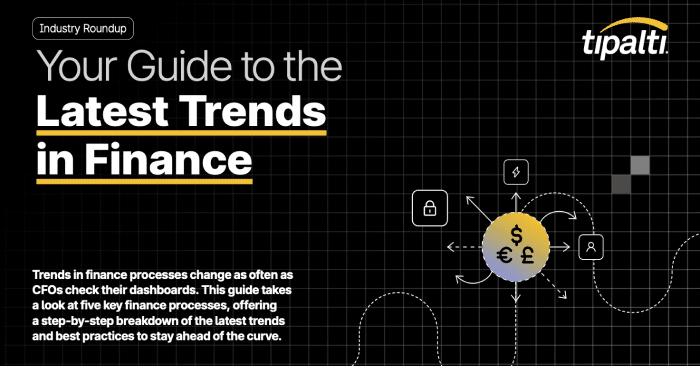
Finance trends shift fast—explore 5 key processes & tips to stay ahead.
Fill out the form to get your free eBook.

Trends in finance processes change as often as CFOs check their dashboards. This guide takes a look at five key finance processes, offering a step-by-step breakdown of the latest trends and best practices to stay ahead of the curve.
If you work in accounting at a fast-growing company, you’ve likely felt it: that tension between scaling fast and keeping control.
Revenue is up, headcount is growing, but your accounting team? Still lean. You’re closing the books with spreadsheets, managing accounts payable by email, and juggling a half-dozen processes that don’t talk to each other.
That’s the reality for most organizations at this stage. Accounting tends to be one of the last areas to get real investment. After all, it’s not building the product or directly driving revenue. But as companies mature, efficiency and control become business-critical—and that’s where the right tech stack makes all the difference.
Building your accounting tech stack isn’t about buying every new automation tool. It’s about planning your investments strategically so finance can keep pace with growth, stay compliant, and deliver better insight.
Start with the Top Automation Priority
When I first started in my current role, our CFO and I sat down to map out what needed to happen first. We treated it like a rebuild from the ground up. The question wasn’t “Which tools are missing?” but “Which processes are holding us back?” That mindset became the foundation for our tech stack.
It’s tempting to chase that shiny new automation tool, but if your foundation isn’t stable, your other processes will suffer. That’s why we started with our ERP. Implementing an ERP is a major lift—no question. But for us, it was the most important one. The ERP is the backbone of accounting. It’s where all your data, workflows, and financial controls live. For us, the goal wasn’t just to stand up software—we wanted to establish a solid structure from the very beginning. We wanted every one of our accounting processes, from order to cash, procure to pay, and record to report, to run through this system.
When evaluating ERP technology, our main priorities were finding a system that enabled both accuracy and scalability. We wanted a solution that could support our growing entity structure, handle multi-currency transactions, and integrate easily with future automation layers. This marked the first real turning point in our tech stack journey.
Add the Next Layer of Technology
Once our ERP was live, the next question was where we could create the most leverage for the team. With a strong foundation in place, it was time to focus on automating the manual accounting processes that consumed the most time and carried the most risk.
We were fortunate to already have AP automation in place, which gave us a head start. It meant we could immediately tackle one of the most complex, high-volume areas of accounting—vendor payments—without relying on manual workarounds. That single decision paid off in terms of speed, accuracy, and control.
For many organizations, though, AP isn’t where they start. Their next technology investment depends heavily on how their business operates. For example, companies with robust sales operations might focus first on the front end of the revenue process and stand up a CRM. Even though CRMs aren’t accounting systems, they’re critical to finance because they feed directly into the order-to-cash process.
However, for most accounting teams, adopting AP automation becomes one of the highest priorities and highest-return projects. AP itself is repetitive, time-sensitive, and a common entry point for error and fraud. But when you automate this process (invoice intake, approvals, and payments), you don’t just move faster—you build in efficiency across every department.
That’s why AP was the next technology priority for us. It wasn’t just about speed—it was about building a framework for consistency and trust in the numbers. Once you have that, every other system you add (CRM, AR, etc.) has a stronger foundation to build upon.
Evaluating FinTech: What to Prioritize and Why
There’s no single blueprint for the perfect accounting tech stack, but there is a logical order of operations.
| Function | Why It Matters | Why Automate It |
| Accounts Payable | High-volume, high-risk process | Streamlines invoice processing, improves control, and reduces fraud exposure |
| Procurement | Pre-spend control process | Enforces approvals, reduces manual effort, and increases spend visibility |
| Expenses | Employee-facing process with compliance requirements | Simplifies submissions, ensures policy adherence, and speeds reimbursements |
| Accounts Receivable | Cash-flow-driving process | Automates invoicing and collections, reduces Days Sales Outstanding, and improves forecasting accuracy |
| Payroll | Compliance-critical, accuracy-sensitive process | Ensures timely and accurate payments while minimizing errors |
| Revenue Recognition | Complex contract process with audit implications | Automates allocations, ensures compliance, and enhances reporting reliability |
If you’re trying to decide where to start, prioritize the highest-volume processes tied to cash movement first. Those are the areas where automation delivers the fastest operational return and reduces the most risk.
Approach Every Technology Project as a Problem to Solve
I’ve done several automation projects over my career, and I keep coming back to the same principle: a successful technology implementation is the outcome of good problem-solving.
That’s what makes these projects so engaging. You’re not just standing up software; you’re fixing inefficiencies across the entire organization. Too often, finance teams approach technology projects as IT exercises—selecting software, managing integrations, and moving on. But the best implementations start with a problem-solving mindset. Ask yourself:
- What’s slowing us down?
- Where are we exposed to risk?
- Which manual steps could be eliminated?
- What insights are we missing because our data is siloed?
That framing shifts technology adoption from a “system rollout” to a strategic project that supports overall business growth.
Scaling Smart: Defining Control Before It Defines You
Most companies grow faster than their infrastructure can handle. But accounting systems are the guardrails that allow that growth to happen safely.
If you wait too long to digitize, you end up reacting instead of planning—patching one-off issues instead of designing long-term solutions. But when you invest thoughtfully, each new tool adds leverage. You start seeing cleaner data, shorter close cycles, and a team that can shift from data entry to strategic decision-making. That’s the real payoff of the right tech stack.
